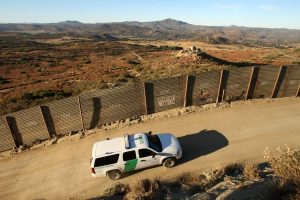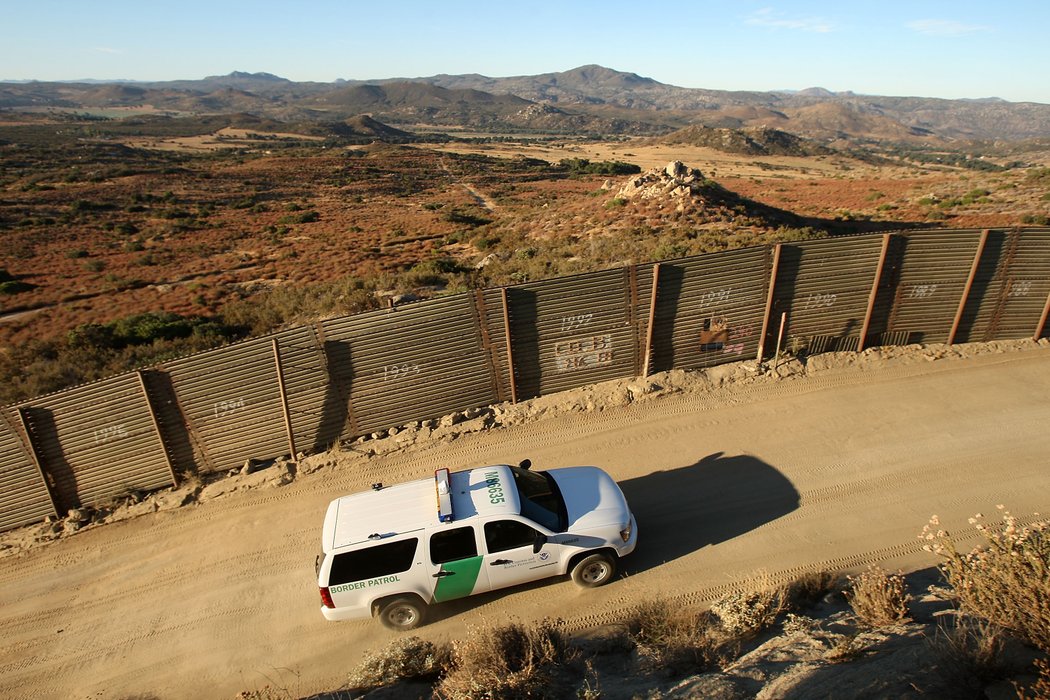In a video message intended for the tens of thousands of men and women working to keep drugs and people from illegally entering the United States, then-Deputy Border Patrol Chief Ron Colburn wanted to leave little doubt about the consequences for those who betrayed their mission.

“The light of justice will ultimately drive you from the shadows,” Colburn said in the 2009 message, one of many produced by the agency to combat corruption in its ranks. “You will find no safe haven among fellow criminals. You will be identified. You will be arrested. You will be prosecuted to the fullest extent of the law.”
The video ended with the sound of a prison door creaking and slamming shut.
But whether most — or even a significant fraction of — corrupt federal border agents really are caught and punished is an open question. In recent years, Customs and Border Protection — the $12 billion law enforcement agency within the Department of Homeland Security in charge of guarding the nation’s borders — has turned to polygraph tests and behavioral research to weed out criminals in its ranks. Background checks are now repeated every five years to make sure agents still pass muster.
But the behemoth agency will reveal little about what those efforts have accomplished. And there is almost no public data to show that its efforts have stemmed the flow of drugs, undocumented immigrants and illegal goods facilitated by the very people whose job it is to keep them out.
Just a few months ago, a report from an outside committee created to advise homeland security officials concluded the current state of affairs at the agency “leaves CBP vulnerable to a corruption scandal that could potentially threaten the security of our nation.”
“CBP must be proactive in its approach if it is to prevent corruption from taking root,” the Homeland Security Advisory Council wrote in the report, released in March.
The agency declined The Texas Tribune’s request to interview officials about its anti-corruption efforts. In statements, CBP has said it takes corruption allegations seriously and that those engaging in misconduct make up a tiny fraction of its workforce.
Data compiled by CBP show that close to 180 of the agency’s employees were arrested, charged or convicted on corruption charges between October 2004 and October 2015 — less than one-half of a percent of its 44,000 law enforcement officers.
Still, outside observers and some homeland security officials have said the dozens of CBP personnel convicted isn’t a true measure of the extent of corruption.
“The true levels of corruption within CBP are not known,” the Homeland Security Advisory Council wrote last year. “Nor is there an evaluation based on sophisticated risk analysis. This means that pockets of corruption could fester within CBP, potentially for years.”
Vetting weaknesses
On paper, it’s not easy to become a Customs and Border Protection officer or a Border Patrol agent. CBP officers work at airports, seaports and official ports of entry; Border Patrol agents work the spaces in between.
The application process includes a background investigation, fitness and drug tests, written tests and oral interviews. Just one of 52 applicants makes it through the Border Patrol process, and one in 28 through the CBP officer process, according to a December 2011 report. The agency also aims to “reinvestigate” employees every five years, once again looking into their backgrounds and searching for possible signs of corruption, such as “unexplained wealth.”
But the system has its weaknesses, reports and officials have said. And it didn’t help when the agency embarked on a massive hiring surge — prompted by national security laws signed in the wake of 9/11 — that swelled the ranks of CBP officers and Border Patrol agents from 27,000 in 2001 to 43,000 today.
Most of those new hires occurred between 2006 and 2008, and the agency has admitted it may have gone for quantity over quality in some cases.
“No one in the senior leadership of CBP was willing to stand up to the White House and say, ‘We can’t hire this many people safely in this short a period of time,’” said Shawn Moran, vice president of the Border Patrol’s main union.
Internal affairs officials later told the Government Accountability Office that five-year reinvestigations fell by the wayside during the hiring push “because resources were focused on meeting mandated hiring goals.” By 2010, CBP was overdue on more than 15,000 of the five-year checks, the GAO report found.
Former CBP internal affairs chief James Tomsheck also said that the private companies contracted to do background investigations — one of the pricier aspects of the CBP hiring process, at $3,200-$3,600 a pop — were cutting corners. An email he sent to the agency detailing his concerns with the hiring and vetting process shows that CBP was aware of the issues back in 2008.
In an April 2008 memo titled “The ‘Perfect Storm’ for CBP Integrity,” Tomsheck wrote that “inexperienced and unqualified persons” were doing background checks on new hires. “We are operating in totally uncharted waters of personnel screening and security,” he continued. (In response to the memo, Tomsheck told the Tribune, CBP was given an extra 90 days to complete its hiring.)
Since its hiring surge, the agency says it has “reviewed and refined its vetting and selection process to ensure qualified candidates are hired for law enforcement positions.”
The Anti-Border Corruption Act of 2010 beefed up the vetting requirements further, requiring lie detector tests for all applicants and strengthening the mandate on five-year reinvestigations. The agency says there is no longer a backlog of those periodic checks.
The impact of those changes is unclear.
CBP is supposed to provide Congress with regular reports of its progress in complying with the 2010 law. The agency has not responded to a Freedom of Information request from the Tribune for those reports.
A staffer for U.S. Rep. Michael McCaul, R-Texas, who chairs the House Homeland Security Committee, declined to provide the reports, saying they are “for official use only.” McCaul’s office did not respond to requests for an interview.
Few dispute that CBP’s hiring and vetting practices have improved. But Tomsheck and others worry most about who was hired between 2006 and 2008 — when the hiring and vetting processes were at their weakest, they say, and when drug cartels and other criminal organizations were recruiting people to apply for jobs and infiltrate the agency.
And major gaps still remain in the vetting process. For instance, background investigators don’t look up an applicant’s criminal record in countries outside the United States, CBP has said.
That may be one reason John Paul Yanez-Camacho, who pleaded guilty to improperly using law enforcement data as a CBP officer in 2009, was hired even though he ran a nightclub owned by a suspected drug trafficker in a Mexican border town, according to public records provided by the agency and news reports.
It’s also likely a reason that CBP didn’t discover that some of its employees had two birth certificates, and therefore questionable U.S. citizenship, until after they had been arrested on corruption charges.
Policing the ranks
Despite facing harsh criticism for its handling of corruption allegations, CBP has garnered a lot of credit for its extensive efforts to root out problems, which have cost $166 million according to a 2012 report.
Recent reports have commended CBP for its practice of randomly reassigning CBP officers to different stations and inspection lanes to make it harder for smugglers to depend on a corrupt officer at a specific location. The agency also limits its officers’ ability to use cell phones.
CBP also has a Division of Threat Mitigation that studies corruption cases to find patterns and prevent good agents from going bad. And the agency analyzes data on cross-border activity at different locations to see if it can identify “red flags” indicating corruption before anyone else can.
The agency produces regular reports — some weekly — on these efforts. None of them have been made publicly available. A Freedom of Information request submitted by the Tribune for the reports in January has gone unanswered.
Tomsheck, who pioneered some of the research programs, said they are valuable but that drawing conclusions on what causes corruption or how to stop it was difficult.
A November 2015 report on CBP’s complaints and discipline system by an outside consulting group said the agency could do a better job of reporting its findings on misconduct.
“The lack of regular and meaningful reporting contributes to a culture of internal and external mistrust and negatively impacts cooperation and collaboration,” the report said. “By enhancing reporting formats for employees, managers and other stakeholders, the Agency would invite healthy and constructive dialogue.”
Few watchdogs
Rooting out corruption and misconduct in CBP requires a well-functioning and fully staffed watchdog unit, and critics say that’s the opposite of what the agency has now.
Ever since the sweeping reorganization of national security agencies post 9/11, CBP has lacked enough internal investigators. Today it has about 200 — fewer than half that of the New York Police Department, even though NYPD has only 34,500 officers to CBP’s 43,000.
The agency plans to hire more. But questions remain about their authority.
For a full decade after the CBP was created, its investigators were only permitted to look into administrative violations — not criminal ones.
That essentially meant that CBP could not investigate corruption allegations against its own employees. That authority fell to the Department of Homeland Security’s Office of Inspector General, (CBP is one of many agencies housed inside the Department of Homeland Security.)
In 2014, CBP’s Internal Affairs Office finally received permission to conduct criminal investigations. But the Office of Inspector General at DHS still has the authority to do investigations, too, and turf wars continue between various agencies over who is in charge of investigating corruption among Border Patrol agents and CBP officers.
An April report from the Office of Inspector General at DHS showed at least four different entities investigating misconduct allegations within CBP. (The FBI also takes the lead on investigating corruption at CBP, much to the discontent of some of the other agencies.)
The same report also criticized the agency’s ways of probing misconduct.
“CBP cannot ensure its investigative operations are being carried out in an efficient and cost-effective manner,” the inspector general’s office at DHS wrote.
Last year, the Homeland Security Advisory Council urged CBP to hire 350 more internal investigators “at a minimum.” Since then, however, the agency has only made plans to add about 100.
“At this pace … it could take almost a decade to get [internal affairs] to the staffing levels needed,” the council wrote in March. “This leaves CBP vulnerable to a corruption scandal that could potentially threaten the security of our nation.”
The Department of Homeland Security says there’s no data to support that claim. If anything, DHS said, there is a “general downward trend” in corruption-related arrests within CBP since a “spike” in 2009.
Indeed, fewer CBP officers have been arrested for corruption in the past couple of years than during the peak time of 2009-2010. But Tomsheck interprets that data point differently.
“Corrupt agents and officers within the ranks of CBP are more cautious” than they were before, he said, so they’re not getting arrested.
Tomsheck added, “I believe there are many in the organization who continue to act out in a corrupt way, who will remain undetected.”
Andrew Becker, of Reveal from the Center for Investigative Reporting, contributed to this report.
This story is part of The Texas Tribune’s yearlong Bordering on Insecurity project.
This article originally appeared in The Texas Tribune at http://www.texastribune.org/2016/07/10/border-agent-screening-improvements/.






















